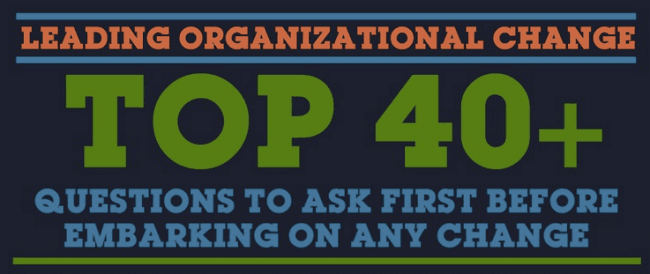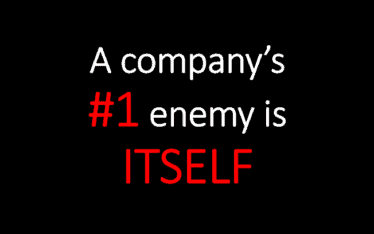Sustaining success depends on an organization’s ability to adapt to a changing environment – whether it’s an external change, such as a transformative technology or a changing economy.
Unfortunately, 70% of organizational transformations fail. Why? Because to many crucial elements in the change process are skipped.
Infographic: Seven basic change management questions to consider
Sometimes we wrongly assume that change is all about improving financial results – stock price, profitability, sales. We forget that successful transformation also generates “soft” benefits, such as trust, new organizational capabilities, and emotional commitment among employees.
But even if we strive for financial and non-financial results, additional perils await: painful emotions that boil up in our workforces whenever we ask people to think or do things differently. Whether it’s anger, alarm, or confusion, we must ease those feelings by cultivating an environment of trust, involvement and empowerment.
Nothing about leading change is easy.
Change management #1 – Urgency
An organizational burning platform exists when maintaining the status quo becomes prohibitively expensive. Major change is always costly, but when the present course of action is even more expensive, a burning-platform situation erupts.
Create a sense of urgency based on the company’s financial performance, competitive situation, market position, technological trends – create a burning platform: What will happen if we don’t react now?
Change management #2 – Compelling change story
Management need to be able to tell a compelling change story that motivate employees. But before you you get buy-in, people need to feel the problem.
People aren’t going to consider anything until they are convinced there is a problem that truly needs to be addressed.
Change management #3 – Current strategy
When dealing with change management it is often required to have a closer look at the current strategy
Change management #4 – Vision and values
Successful change is hinged on a picture of a desirable future. Vision can provide both a corporate sense of being and a sense of enduring purpose. Without a sensible vision, change efforts can dissolve into a list of confusing projects that take the organization in the wrong direction. It is important that the vision be easy to communicate. Create a shared vision, values and common directions.
Change management #5 – Communicate
Communicate this information broadly and dramatically, especially with respect to crises, potential crises etc. To successfully implement change initiatives, organizational leaders must identify the need for change and communicate it throughout the organization.
Infographic: Top 10 ways social media can facilitate change management
Change management #6 – Create a dialog
Involving employees right from the start, where they have influence in the strategic plan of the organization, tends to reduce employees’ resistance, which is always a very important factor in the success of any organizational change.
Change management #7 – Culture
All change in organizations is challenging, but perhaps the most daunting is changing culture. When ever possible use storytelling – storytelling can be a powerful tool when you want to drive organizational change.
Change management #8 – Visualize the “journey”
Not only is it easier to communicate something using a picture, but it’s also much easier for people to remember things that have been communicated to them visually. People remember 10% of what they hear, 20% of what they read and 80% of what they see and do.
Change management #9 – Measure
Measurement should be considered during the planning of change and before any action is undertaken. Measure early and often …… and tell about it …… Without measures of success, the organization does not know if it has succeeded in its efforts. Someone once said, “What gets measured gets improved.” Someone else said, “If you don’t know where you are going, any road will get you there.”
Change management #10 – Create wins
It is critical for teams and individuals working on change to achieve small wins regularly. So if you want something to grow, don’t forget to pour champagne on it.
Change management #11 – Align performance management
Align performance management processes to drive desired behavior changes
Change management #12 – Lookout for inconsistencies
Continuously lookout for inconsistencies – Deal proactively with resistance
Infographic: Top 40+ questions to ask first before embarking on any change
Companies most likely to be successful in making change work to their advantage are the ones that no longer view change as a discrete event to be managed, but as a constant opportunity to evolve the business. Change readiness is the new change management – the ability to continuously initiate and respond to change in ways that create advantage, minimize risk, and sustain performance.
Short URL & title:
Top 12+ important elements for successful change management effort — http://www.torbenrick.eu/t/r/kho
Share it:
If you enjoyed this article, please take 5 seconds to share it on your social network. Thanks!











Torben,
You have done a good thing in presenting the framework for positive organizational change. Thank you for illuminating your perspective on this vital concept.
I work with for-profit as well as non-profit organizations and find these elements most helpful when I engage the people most affected by the proposed changes, enlisting them in the planning stages, giving them ownership of the outcomes. When people have an intellectual and emotional equity investment in the change process, they “buy-in” and self-police those who resist or attempt to undermine their new empowerment.
Thank you for the embedded presentation you provided. Even the parts in German were very instructive. With your permission I want to forward your insights to a friend who is a professor of administration for a seminary in the USA. I believe these principles would be helpful in the hands of pastors seeking to guide their congregations. I will of course provide clear authorship credit and contact information through your LinkedIn page.
Regards,
Sam Shorrosh
Principal, SAS Business and Operations Management Consulting
USA
It was a useful Article for my course work subject in PhD
Thankyou,
M.Balakumar
Thank you for explaining in detail what change management is in an easy to undestand manner. I have to write about change managemnet, but my professor wrote gave the following assignment without further explanation: Research and submit a two-page paper analyzing change management approaches that support the learning organization philosophy. Thanks to your article, I have some understanding of what I am suppose to do. Thank you!
Many thanks for sharing the useful change management framework. In practice, I suppose any serious CM effort should be mapped out phase by phase, step by step with achievable mine-stones – in a first-thing-first manner.
A strong leadership with the political will and ability to rally the troops and bring about the desirable changes is key. Obviously, typical one-off rhetoric campaigns launched by top guns followed by some publicity and/or a few instant awards without serious follow-ups and accountable reviews are misguided or just for show – for some PR or untold purposes.
Cheers!